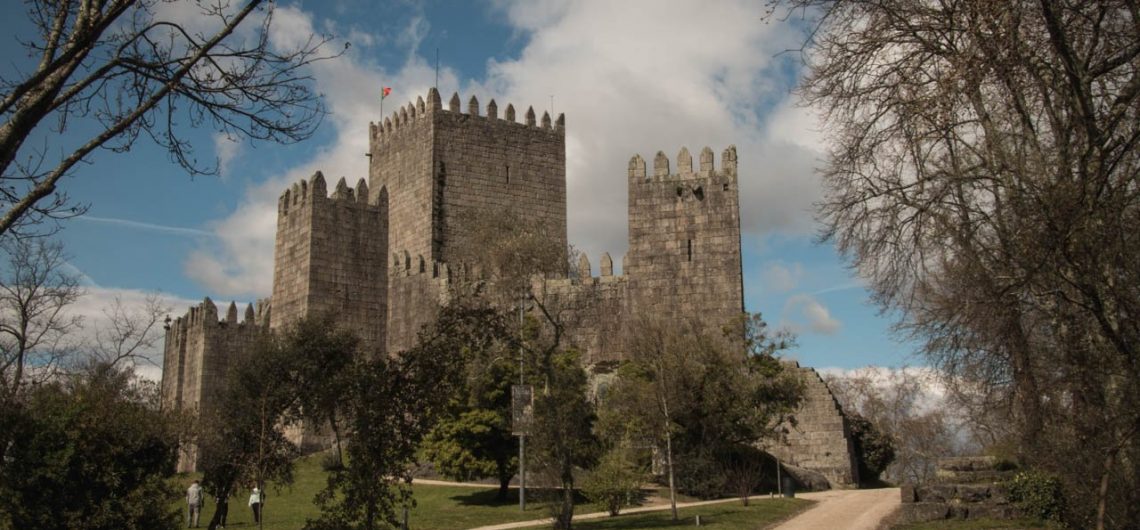Another sweet dawn and I’m sure that I will have a very well spent day and it will end in the best way, to see another theater play.
Today our tour will be to the cradle of the nation, the city of Guimarães. For those who are lovers of the country, of this wonderful Portugal, this city is always an inspiration. It is a city with a glorious historical past that is associated with the foundation of the national identity and the portuguese language. It is certainly one of the most important historical destinations in the country. Ancient Roman city, was chosen by D. Afonso Henriques (our first king) to be the capital of the kingdom, after the victory in the battle of S. Mamede, in 1128. It was classified as World Heritage of Unesco in 2001.
When you arrive in Guimarães there is always a good feeling that I can’t explain, but I think it’s because I’m portuguese. I want to shout very loudly “Viva Portugal”. We start at the hill where two remarkable examples of the Vimaranian heritage stand: The castle and the Ducal Palace. BEAUTIFUL!
The Castle of Guimarães was built in the 10th century , being extended in the 11th century. Says the legend that D. Afonso Henriques was born here. In 1910 it was classified as a national monument.
The Ducal Palace dates back to the 15th century, and it has, in its interior, a set of Flemish tapestries and Persian rugs, superb. Both are well worth a visit.
Then we continue our journey right through the main square, the Oliveira Square.
It’s so nice to go down calmly enjoying the surroundings. A real labyrinth of winding alleys, flanked by old houses, decorated with statuary.
Suddenly we see the Salado Pattern in the center, which is a Gothic pearl (style that I like so much) and on the left side is the beautiful church of Nossa Senhora da Oliveira. This church was founded by D. Afonso Henriques and underwent a restoration in the reign of King João I in 1835, after the victory in the battle of Aljubarrota. The tower is Manueline (a style that is only portuguese).
There is a curious legend associated with this square that I think is worth telling here. There was an olive tree in front of the church, which olives were used to provide oil to the altar lamps, but dried up and died. Later, a merchant put a cross on the exact spot where the olive tree once existed. Miraculously the tree came back to life. Unfortunately the one that exists today is not the original.
It is lunch time and there are many good restaurants in Guimarães. We chose one that, apart from eating very well, is a happy recovery from an old building, Papa Boa. I recommend.
Our afternoon will be spent on the mountain of Penha to enjoy all the nature and the best views over the city.
We will climb the cable car, probably the first to start operating in Portugal, in 1955. The climb is very pleasant and allows us to have an aerial perspective.
The mountain of Penha, although it goes back to the prehistoric period, its occupation took place in the last three centuries, was when the relation of the men with the space happened. The men wanted to build a place of worship here and “faith moves mountains”. Today there is a very important sanctuary for the Catholic religion and that is a true place of pilgrimage. It’s a fascinating place where granite rocks predominate. There are a set of caves, gorges, fountains, cliffs, large trees, all ready to be discovered and appreciated.
The devotion of men does miracles. Man with nature and faith leaves a valuable legacy.
It’s time to go down to dinner in Oliveira Square, on a terrace where you feel like sitting and taking more time than necessary, looking without haste for every detail. We had dinner calmly, but now we have to go to the Alberto Sampaio Museum where we will have the real privilege of seeing a play. I think it’s an unbeatable duo, a good play in an unlikely and so beautiful place.
The Alberto Sampaio Museum has one of the most valuable collections of tiles and sculptures in the country. I emphasize a beautiful triptych in silver, that represents the visitation, the annunciation and the birth of Christ. But the ex-libris of this place are, for me, the cloisters, gorgeous.
Here we go up an ancient staircase that takes us to a small wooden room, cozy, where we feel special. The historical play was very well performed, with a fantastic wardrobe. Congratulations!
It’s time to say goodbye and it looks like we miss it already. We’ll come back soon!
Maria José Dias
Pictury Photo Tours



